|
|
| PREV | 1930| NEXT
| |
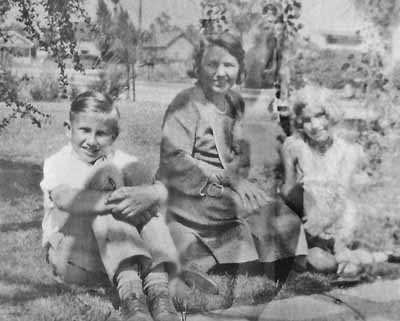
Bob, Judie, Marian
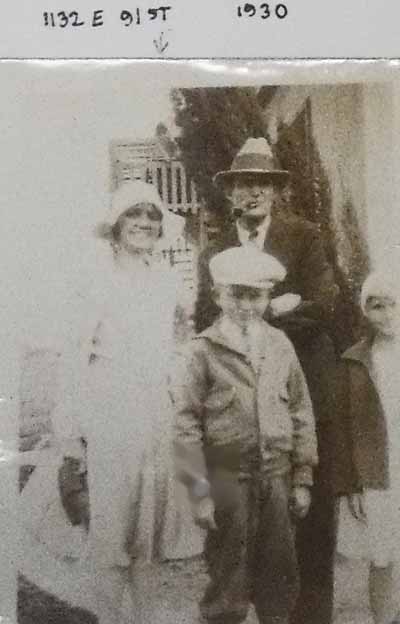
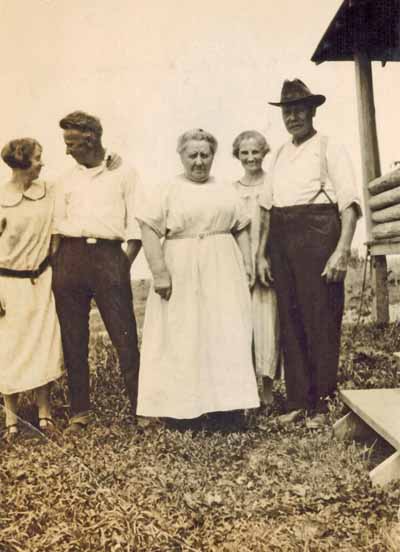
Judie's parents & family about this time
Bob believed his family moved to 435 E 80TH ST, LOS ANGELES this year.
Bob recalled in 2012:
Close association with Tim Gorline and his widowed mother Myrtle starting in 1930 is a wealth of fond memories. I don’t recall them clearly, but a
brief summary seems in order.
Timmer’s father was a motion picture projectionist. Tim was born in Montana, and the event that caused the family to move to Los Angeles was the destruction
of their home in a forest fire. Part of Tim’s inheritance was a motion picture projector and a small library of Laurel and Hardy films, which made him
uniquely popular with our neighborhood gang at 80th and Avalon. Myrtle was employed as a document copier by the LA County Recorder. Her daily regime was piecework,
and she was proud of her ability to complete her daily assignments long before the end of the 8-hour shift.
When I had a day free from school, she would drive Tim and me downtown in her 1925 Model “T” Ford coupe and we would spend her short day, exploring and adventuring and usually find her waiting for us in her
car parked on Fort Moore Hill. Tim was excused from attending the public school because of a severe asthma condition and Myrtles efforts at home education was somewhat more successful than local public schooling was on the rest of us.
Tim’s house was a chem-lab where the pipe bombs were made. Tim’s backyard was a replica of the trenches of the Great War, complete with underground bomb shelters where we kids fought with brickbats and suffered occasional
injuries.
I, myself caught a case of trench mouth and this was before the age of anti-biotics. One cutting edge of Tim’s home-ed was his subscription to the Scientific American magazine, which issues I should review regarding, for instance, Wegener’s Continental Drift, etc. A cement fishpond complete
with craw-dads, pond-scum, pollywogs and turtles on rocks and a microscope inside to study that stuff. Later, when we renters moved apart, Myrtle would invite and transport Tim’s friends so we could spend weekends and school vacation time at their houses across town, in Monterey Park, and Tujunga, where the dryer
climate favored Tim’s asthma.
From Tujunga, long camping hikes in the San Gabriels filled out my school vacation years. Once, Tim suggested to Myrtle that she shop for some more concentrated food for his rucksack. She came back with an assortment of Gerber’s baby foods, which was a close-to- starvation experience for us.
Myrtle had a friend who let us stay in her very isolated cabin at Hi-Vista, and we drove Myrtle’s Ford up a canyon of Adobe mountain where the axle broke, and Tim and I walked 12 miles to the nearest telephone where we called my father who drove up on a Sunday and towed us back to LA. Other times, Tim and I drove down to Baja, climbed Mt. Whitney and painted our initials on a
rock below the summit in red enamel.
Remembering the week(in the early 1960s) that Flossie(Tim's wife) died, it was explained to me much later, when Elsa, repeating women’s gossip via Ruth: Flossie had explained that Tim, who carried a machete under his car seat, was being bullied by a colleague at
the machine shop where he worked about a parking place dispute, and in self-defense, Tim slew the guy with his weapon. Tim, upon returning home, where his wife was in her last days of terminal cancer, clandestinely used cyanide, simulating death by a heart attack.
Tim is buried at the veteran’s cemetery at Point Loma. This all happened in one week, including Flossie and Tim both dying, and we were all frustrated by the arrangement Flossie had made on her deathbed with a neighbor friend, to have her two sons flown to her family in Virginia.
For the past 50 years, I have felt guilty of not doing more for my friend Tim’s family after that tragedy…
| |
|
|
| PREV | 1931| NEXT
| |
|
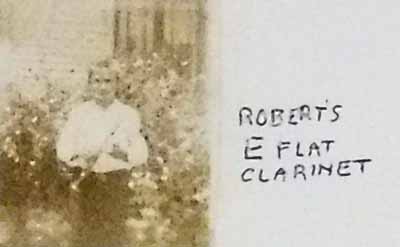
| |
|
|
| PREV | 1932| NEXT
| |
|
Bob believes this is the year the family moved into a house and stayed for a long time - about 16 years - at 312 E 91ST ST, LOS ANGELES.
As to how accurate his stories are (there are errors), Bob recalled in 2019:
There are various qualities of history....Compare oral hearsay -- He said-She said, Congenital liars or trusted friends with documented journalism, which wins after I am cremated......
At age 11 years, I sat spellbound as our next-door neighbor, Tom Lawson (retired ex-mayor of the city of Signal Hill, who allowed me to use his tools in his workshop, drank medicinal alcohol with his neighbor Jim Baylis, as old Jim told his experience in the US Army Signal Corps, of how he was required to pull the dogsleds (Private soldiers were more reliable than dogs), where the Corps wintered on Ellsmere Island on an unsuccessful search for the British Franklin Expedition.... My search for confirming information on the laptop named a dozen people who participated in the Expedition, but there was no mention of neighbor Jim.
Bert' Nathan B. Smith years later told me that he was the one who, for commander Ellsberg in his navy dry diving suit, used a high-pressure nozzle water jet to burrow his way under the sunken submarine 'S-54' to pull lifting cables under the sub's keel. After reading Ellsberg's 'On the Bottom', I learned that Diver Smith's name was Francis Smith..
| |
|
|
| PREV | 1933| NEXT
| |
|
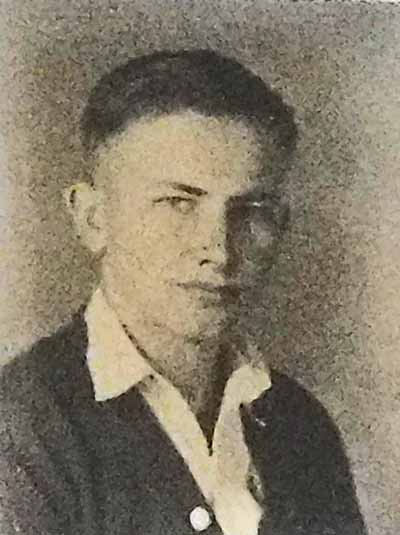
Of the great 1933 LA earthquake, Bob recalled:
On Friday afternoon,March 10, 1933 the students of Bret Harte Junior High School had the opportunity of watching a stage play performed by the school's Drama Class. I have forgotten the name of the play, but I do remember thar Edna May Durbin sang a part. Later, she changed her name to Deanna (becoming a famous actress, at one time the equal to Judy Garland).
At 5:45pm I was kneeling in front of our family's radio console turning on my favorite program, "Little Orphan Annie", when the house jerked so hard that the marble statue on top of the console was hurled down on me and I caught it in my arms, and, with everything shaking wildly around me, bolted out the front door, stumbling to the middle of 91st Street, still carrying the statue.
The concrete pavement, as I looked East toward Avalon Boulevard seemed to have waves advancing rapidly. The line of wooden utility poles were doing a jerky dance. Wires were snapping and fallen snaky wire ends on the ground sparking and singing a menacing 60 cycle hum.
Half of the houses on our street were sitting on inadequately-braced props which toppled. Water and gas erupted from the street and for two weeks I carried household water from the water company's well pump, 6 blocks away. A tall brick incinerator chimney attached to the school's brick auditorium collapsed into the seats that we students had been occupying 2 hours previously.We all survived, using Sterno canned heat to cook with and played Monopoly by candle light in the evenings.
Regarding extracuricular activities this year, Bob recalled:
While attending Bret Harte Junior High School in south LA, two of my schoolmates told me there was a job selling newspapers on a street corner to passing motorists. Don and Duane sold the Evening Herald and the job open was to sell the Record. You earned one cent for each paper sold. Don and Duane shared the two heavy traffic signals, charging 5 cents for the Herald and I had a monopoly for charging two cents for the less popular Record. The afternoon street corners traffic sales netted the three of us between 25 and 50 cents per each peak traffic day, less than $2 per week. Since we each came from families enduring financial difficulties, these wages helped for our necessities.
Don and Duane were dues paying members of the BSA and I went to the meetings at a local school. One advantage of my brief membership consisted of participation in two camping trips. I spent a week at Camp Arthur Letts in the Hollywood Hills (located near the hilltop mansion of film actor Errol Flynn), where all the boys swam naked in the pool. Then we camped in tents for another week in a valley adjacent to the LA sewage disposal pier at El Segundo beach where the camp’s sanitation consisted of each camper using a shovel and squatting over a shallow hole dug in the sand dunes behind the row of tents. We were allowed to fish for the halibut, mackerel and tom cod that prospered under the pier. One experience I had with these Boy Scouts was that some of them had a weird idea about “Scout’s Honor”. After one meeting, we went into an ice cream parlor. While we were waiting in line to pay for our ice cream, an indecisive lady ahead of us in line with one selection on the counter waived us ahead on her while she went to make another selection and we paid and left the parlor. Outside, my scouts were cheering one scout who had also carried out the lady’s selections that sat on the counter.
Bob also recalled, after son-in-law Doug sent him a Zane Grey book in 2011:
In 1933 our neighbor
who lived across the alley had the only show in town that would interest a 12
year old. Alden Richardson, a 40 year old man kept his garage door open for
ventilation while he earned his living manufacturing fishing equipment. His main
product was a 12 foot long fishing pole, made from Calcutta bamboo, ruby-brass
leads tied on with colorful silk thread, rigged with turks-head knots, etc,
top-of-the-line beautiful work coated with multiple coats of varnish.
He enjoyed the diversion of us kids being his audience, so much that he occasionally
entertained us with his yarns. Alden's other enterprise was his small machine
shop. He would buy an off-the-shelf deep sea fishing reel and increase its length
of fishing line capacity by making the reel wider. He explained that a
sports-fisherman trying to land a large gamefish must sometimes "play" the fish
for hours until it tired and landing the fish involved having the option of
having enough fish line to release while using the reel brake to make the fish
work itself to death. When you had no more line on the reel, all you had left
for working the fish was your poles' flexibility, and when you came to that, the
fish could jerk out the hook.
One of Alden's customers was Zane Grey, who Alden
said, took Alden on one of his expeditions to New Zealand, to demonstrate to him
his need for a wider fishing reel!
| |
|
|
| PREV | 1934| NEXT
| |
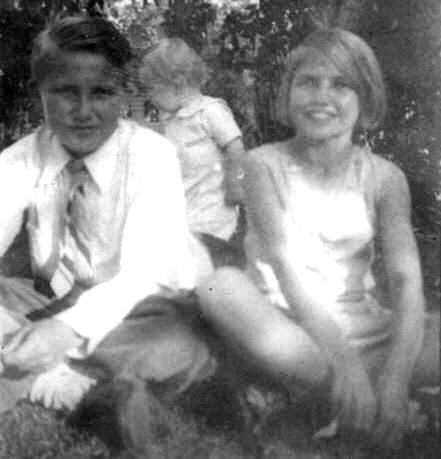
Bob, Marian, and cousin Freeman in background
Bob recalled:
"In the semi-tropical climate of Los Angeles we had in some winters a background of snowcapped mountains, which would inspire my father to tell us kids stories about his youth back in Ironwood Michigan when he was a ski-jumper following his immigrant parent's Swede traditions. He said he made his own skis, and would make a pair for me, if I would go to the lumber yard and get 2 hickory boards, 2"x 4"x 7 feet long. At the lumber yard, they did not have hickory, but they had oak, so that is what I brought home.
"My father, with his gasoline blow torch, then boiled the 12" ends of the oak pieces overnight and bent the ends in a wood form that he made using clamps. The next day he carefully whittled the pieces to the shape of skis, carving a slot through the middle foot-part for a pair of leather buckled shoe harnesses, which he cobbled from an old pair of boots,and coated the bottom of the finished skis with hot beeswax. I owned a pair of skis and now could go cross country skiing with the Boy Scouts!
"I used these skis for several seasons and learned to use canvas climbers, necessary to improve traction while herringboning up the slopes for hours in order to enjoy minutes of downhill at places like Christmas Tree Hill, or the Big Draw on San Gorgonio Mountain."
Bob also recalled:
"In 1934, my neighbor, Tim Gorline, moved from south Los Angeles because the smog in LA bothered his asthma, to Tujunga. Tim's mother invited me to travel there on the bus and stay for the weekend where Tim suggested that we hike to the top of nearby Sister Elsie Peak. His house was probably the highest one in the town near the mouth of Haines Canyon where a rock crushing plant actively mined and refined building materials from the alluvial fan. The plant hosted a series of settling ponds well attended by all sorts of the local wildlife and as we passed it on our way up the truck trail, we tested the inch-thick ice by heaving a cobble stone.
"The trail ascended alongside the creek, babbling amongst large well rounded boulders and canyon bottom trees and soon we were traversed out of this onto the more barren mountainside from which widely scattered patches of the Chapparal were just surviving, Spanish Bayonet, Manzanita, Sage and Buckwheat. The eroded trail would soon require maintenance for vehicles, but hikers could pass trail blockages such as rockslides.
"Five miles up to the top,where the climate zone change allowed the low brush-cover to appear more impenetrable for hiking short-cuts between the numerous switchbacks, was the thirty-foot tall lookout tower, ladder up to a railed veranda encircling a fully glassed cabin in where we were welcomed by the lonely Firewatchman.
"In the center of the cabin was a map table upon which lay a scope used to take bearings on distant smoke, possible beginnings of a wildfire and a telephone. On the mountainous horizon through the scope were several other peaks with similar towers, Josephine, Mendenhall,Geason and Vetter, there to triangulate and pinpoint destinations for mobilizing fire suppression crews. Many years later,when I was suffering from Myopia and needed glasses fitted, the eye doctor told me that instead of doing paper work in an office, I should get a job as a firewatcher in such a tower where my eyes could stay continouously focussed on distant objects instead of printed papers."
| |
|
|
| PREV | 1935| NEXT
| |
|
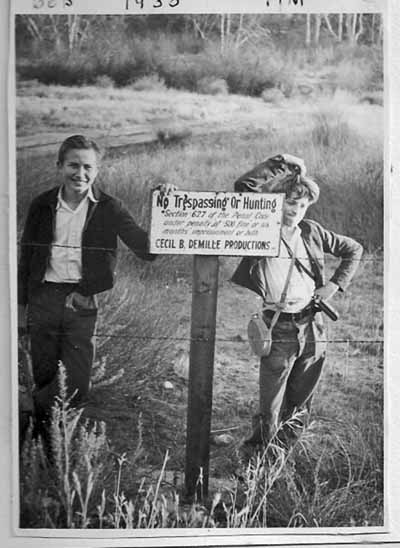
Bob and Tim Gorline were "gone with the wind" before being caught trespassing.
According to Bob, "Tim is in his Stan Laurel pose for the benefit of Cecil... just in case we got caught."
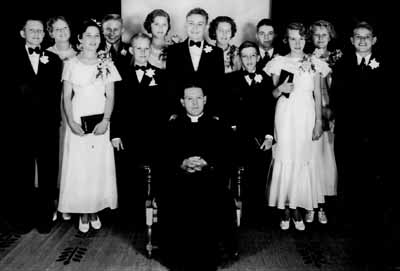
Bob is 4th from left at his confirmation ceremony, Faith Lutheran Church, Figueroa at 93rd Street,about '35. Reverend Carl Berner, Missouri Synod. The only name that I remember of this group of 13 is the tall boy in the middle back, Rene Anderson, pronounced 'reeen'. Ten Saturdays of rote instruction and a quiz, then this barely affordable dress-up for the ceremony
Bob continued his education this year. Finishing junior high and starting high skool.
| |
|
|
| PREV | 1936| NEXT
| |
|
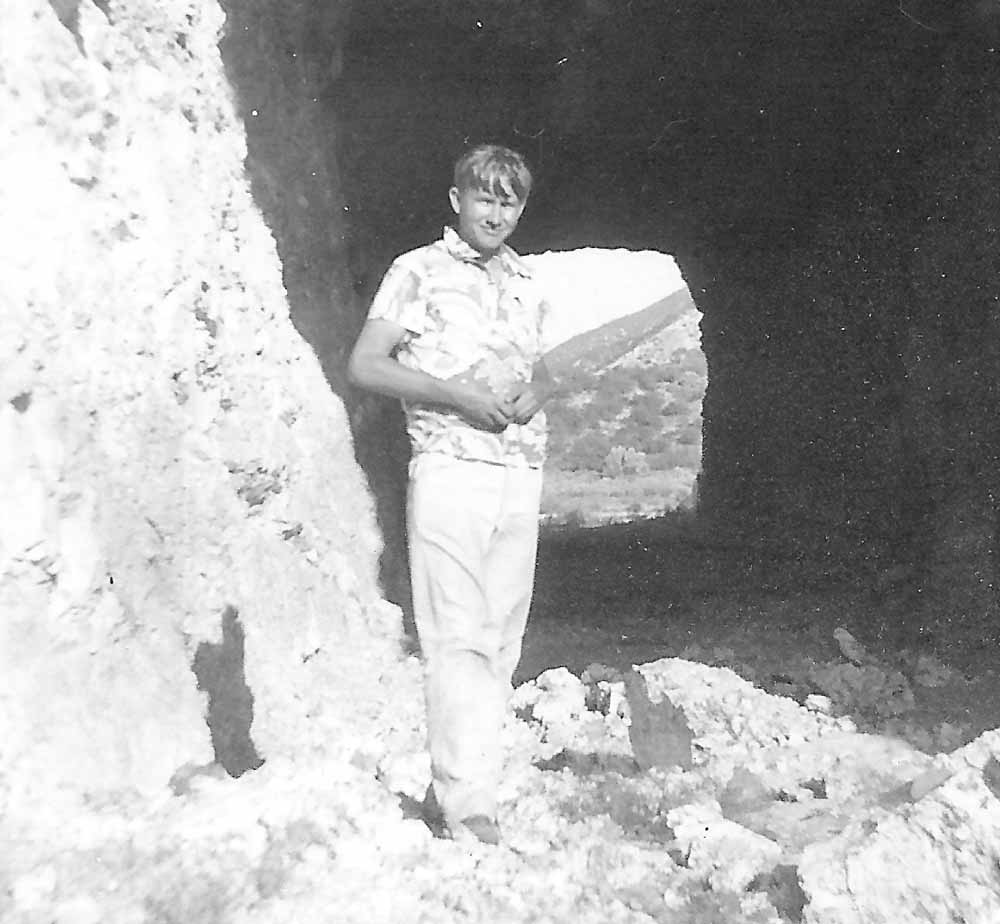
Bob

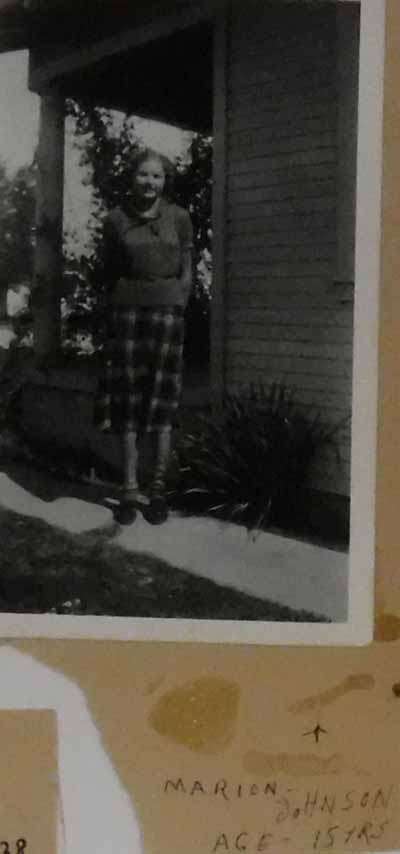
Bob remembered:
"In the coastal basins there probably always been times of noticable atmospheric pollution, caused by natural wildfires.On the athletic field in our high school early winter 1936 mornings, the pall created by protecting the local citrus crop from frost by means of much burning of old tires and waste oil in smudge pots, combined with fog coined the word smog. I remember, as the burgeoning populations propensity for one man automobile commuting grew exponentially, that while driving down from the mountains into the LA basin, the encountering of this dark wall of smog seemed an incentive to make a U Turn. Control of the chemistry of motor fuels has greatly reduced the eye burning life shortening indoor closeting(bubble wrap) effects and the damage is democratic.... what happened to the cruising top-down convertibles? ...the topless hot-rods?"
About his father's situation this year, Bob explains:
"About 1936 my father began working for the US Army Corps of Engineers, first on the Prado and the San Gabriel Canyon earthfill flood control dams as an oiler, then as a mechanic on the lining of the Los Angeles River, finally on the Playa Del Rey harbor.
"We, his dependents, were relieved to have him working again recovered from his injuries sustained as a chipper for the Bethlehem Steel Company. One Sunday he drove our family to behold one machine that he oiled, The Bucyrus "Monaghan" dragline excavator. Our automobile could be hidden in the scoop. The cab, containing the operator, cable drums and engine seemed the size of a barn. The cab was pivoted and balanced atop a large pontoon equipped with a mechanism that would transfer the machine's weight to 2 similar pontoons, one on each side of the center pontoon, so that the side pontoons could either lift the center pontoon off the ground, and deposit the center pontoon 3-feet forward, or back, or rotate the center pontoon one way or the other.
"What it did to the center pontoon, it also did to the cab and the 200 foot dragline boom. Instead of being wheeled, or moved by caterpillar tracks, this was a walking behemoth which had been used to dig the Panama Canal.
"Once while he was working on the LA River servicing a diesel Caterpillar D8 tractor in the bottom of the river one rainy night, a supervisor drove up and told him to drive the tractor 3 miles upstream to the exit ramp to try to save the tractor, since an unexpected flash flood was coming down the channel. That instruction came too late, because the tractor was soon being drowned by the fast rising water before my father could reach the ramp.
"He stopped the tractor beneath a pipe suspended on cables across the river and standing on the tractor's roof was able to save himself from the flood by climbing to the bank on the pipe.
"Another time my father had come on the midnight shift of a job repairing a D8 Cat, which the previous shift men had jacked up on supporting blocks, and while working under the tractor, the blocking failed, crushing my father's shoulder.
"When my father started working for the Corps, a sales person from Mutual Benefit Insurance Company of Omaha sold accident insurance to the new employees and it was my father's duty to pay for his insurance out of his pay.
"It so happened that this sales person was pocketing the money and my father was obliged to pay his medical bills for this accident out of the family savings. Trust insurance companies no more and build up your savings, became our motto."
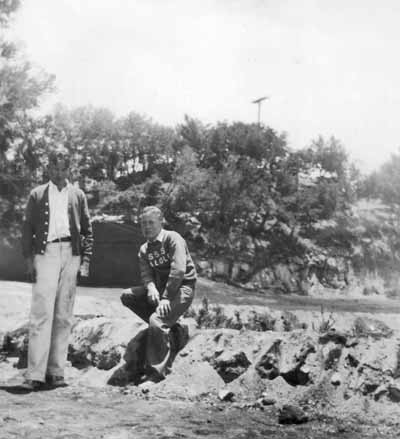
| |
|
|
| PREV | 1937| NEXT
| |
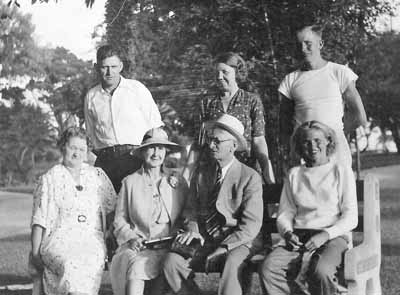 Back row: Thor, Judy, Bob. Front row: Pearl Lamont(the grandmother of Marian's neighbor friend Pearl Hosterman), Mrs. and Mr. Ed Burroughs, and Marian. According to Bob, "Ed was our 'across-the-alley' neighbor, who was a retired photographer from Tombstone AZ. He was in Tombstone at the time of the Earp-Clanton shootout at the OK Corral, and taught me how to develop my own photos". This park bench is in Bixby Park, Long Beach Back row: Thor, Judy, Bob. Front row: Pearl Lamont(the grandmother of Marian's neighbor friend Pearl Hosterman), Mrs. and Mr. Ed Burroughs, and Marian. According to Bob, "Ed was our 'across-the-alley' neighbor, who was a retired photographer from Tombstone AZ. He was in Tombstone at the time of the Earp-Clanton shootout at the OK Corral, and taught me how to develop my own photos". This park bench is in Bixby Park, Long Beach
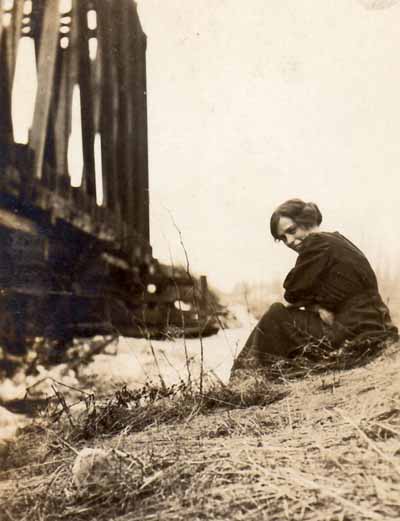
Myrtle
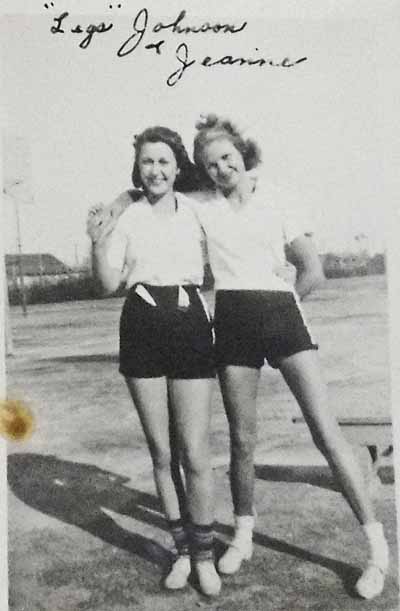
Jeannie? & Marian
Bob recalled(circa 2010):
In 1937 Tim's mother, Myrtle Gorline bought a new Ford Coupe and Tim, at the age of 16, had his driver's license. Myrtle had a friend, Gertrude Munson, who had a cabin in Hi Vista, 20 miles east of Lancaster, so I rode in the new car, Tim driving, up to the cabin which was a simple waterless shack, 3 miles beyond the Hi Vista village, where Gertrude had a real estate office.
Some inhabitants of this extremely scattered desert community were pensioned war veterans who had been granted 160-acre parcels of land as a reward for their service by the US government. Austere living in beautiful isolation at the ends of long rough trails, cooperating with each other hauling their weekly supplies of food and water apparently appealed to them. Myrtle had explained to us that, while these "Desert Rats" appreciated visitors, it was considered inappropriate when visiting to ask for a drink of water.
We camped in the cabin overnight and in the morning we decided to drive up toward Shadow Mountain, the nearby hill. Tim was driving up a sandy drywash,when the cars left rear axle broke. We then walked west 10 miles to the nearest telephone and called Myrtle in Tujunga.
Myrtle called my father in LA and the next morning my father arrived at the cabin in his 1929 Essex Sedan with a tow chain and towed the Ford back to LA, Tim learning to follow and keep tension in the chain.
In 1960 The County Board of Supervisors referred a petitioner from Hi Vista to the County Engineer and I was the employee delegated to deal with it. Hi Vista is entirely situated on a large nearly level granite outcrop, having no underground water, and lying east of the Antelope Valley Groundwater Basin, the nearest water resource.
I wrote a proposal that the people have an election to form a 30 square mile tax district and authorize a 3 million dollar bond issue for drilling a well in the adjacent Basin, lay 30 miles of pipe, and construct a half million gallon tank atop Shadow Mountain.
I went to local meetings to explain this to the voters, and at an election, they approved it and inside of a year the water was in the pipes, and Myrtle's friend, Gertrude was one of the new tax district's first customers to not have to haul her water 10 miles.
Joe Cosney, responsible for maintaining and operating the Antelope Valley water districts reported soon after to us that a man from LA with his family on a desert day-trip visit to a remote place in Hi Vista, was caught camped next to one of the fire hydrants, where he had built a small dam in an adjacent hollow, and made for his family's enjoyment a swimming hole with water from the hydrant.
Bob recalled (in July 2015):
My companions of the past winter, Don Rydeen and Duane Raymond who were sometimes members of Boy Scout Troop 35 and competitor newsboys on the corners of Manchester Blvd. and Figueroa St. Invited me to camp with them for two weeks at the San Bernardino National Forest Grout Bay Campground at Big Bear Lake. Duane’s father let us drive the family car equipped with an umbrella tent, but we had to bring our food and stuff, and buy the gas. We each had about $10 to buy snacks and gas.
We decided to each spend $2 for a horseback ride. I had never ridden before, so Don and Duane plotted to inform the wrangler that I should get the big horse since I had the most experience. They had ten riders who were to be guided around a 2-mile trail. While I was first in the saddle and the other 9 were getting saddled behind me, my big horse was so raring to get this ride over with that he took off galloping. And my first ride took me around the track in less than 4 minutes. The wrangler was spitting mad, Nevertheless, I spent the next hour in the dust of the other 9 riders, but getting twice the mileage as my companions.
Later the next week, Duane’s car wouldn’t start and we pooled our remaining money buying carburetor gaskets and fruitlessly tinkering. Duane’s father said on Tuesday that he couldn’t come up to tow us back to LA until Sunday. We were financially broke and we had a can of corned beef, a can of beans and a dried-up half loaf of white bread to last us to Sunday… So we said, ‘Let’s climb Grayback’. San Gorgonio Mountain was a 50 mile round trip from Groueeet Bay and a 10,000 foot climb and descent. Halfway to the mountain, we came to an apple orchard and stole a hat full of small green apples. We arrived at Dollar Lake that evening and supplemented our meager diet with what we found by sorting the contents of the campground garbage can. We found a half-full can of Hershey’s Cocoa swarming with ants. Boiling this with lake water and stirring vigorously made it possible to decant the ants and it was quite acceptable. We climbed to the summit and finished our beans Thursday. And snacked on hard green apples,
otherwise enduring hunger until Sunday morning.
My mother commented that night about the way my face bones stuck out. I recommend a week of teen-age starvation as being an essential factor for gastronomic appreciation. Bon apatite!
Jef thinks face bones sticking out is more a sign of dehydration than starvation - lacking the salt found in the canned goods and getting by without canned goods for the last few days probably caused pretty severe dehydration.
| |
|
|
| PREV | 1938| NEXT
| |
|
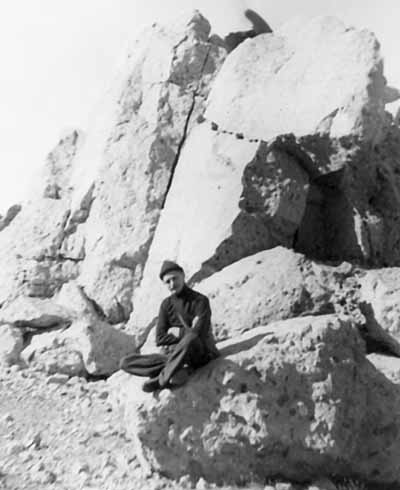
The photos show the ruins of the San Francisquito Dam failure with Tim for scale.
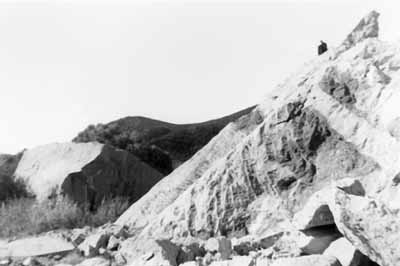
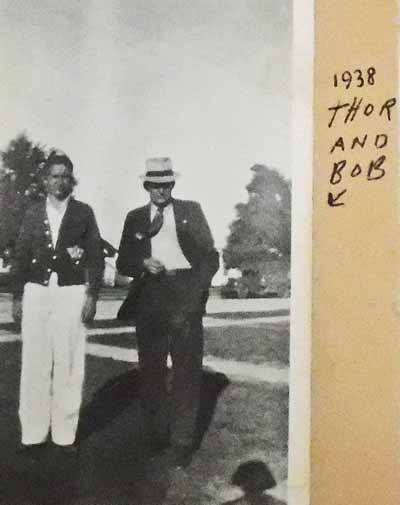
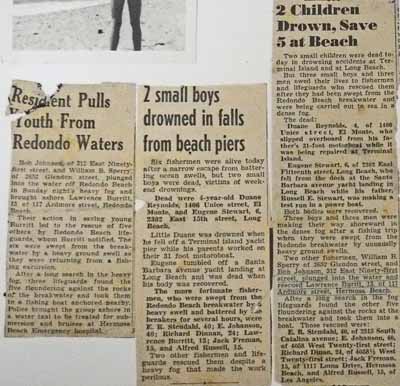
Bob recalled:
"When I graduated from Fremont High School in June 1938 I wore down the soles of my shoes walking around Los Angeles following up many employment ads. One August afternoon, while I was playing workup baseball on 92nd Street, a lightly travelled wide street, with the neighborhood kids, a stranger who had apparently been watching our game from his car, parked down the street, came up to my position in the outfield and asked me if I wanted a job. "Yes Sir" I said.
"Nathan B. [Bert] Smith was an engineering contractor whose specialty was pile driving. He had an acre fenced yard where he stored a complete set of antiquated equipment....a 3 drum steam donkey engine on wood skids, a Worley steam powered crawler crane, which always crawled straight until the operator stopped and got under and connected a chain to disengage one track so the other track could turn the crane to a new direction, then get out and use the chain to reengage the track so the machine could proceed. He had in his tool shed a complete dry diving suit outfit for underwater work, everything needed for railroad track work, steel building erection, and housemoving, etc. His work crew consisted, mostly of elderly seafaring men, experienced in ship rigging, happier to be working ashore.
"One was a New York Indian, a skyscraper steelworker, who taught me to catch and throw hot rivets, 10 stories up, all very loyal to Bert and defensive for me, the new apprentice who worked for 25 cents an hour, which was frowned upon by Mike Ryan, the Steelworker's Business Agent. Atop the cab of The Fageol flatbed truck, 2 Toggenberg goats presided over Bert's yard, exceeding the duties of the junkyard watchdog.
"When it became known that I had taken mechanical drawing courses in school, I was required to help making the cost estimates and prepare bids for contract opportunities. Since the region had experienced a disastrous flood the previous winter, we were successful in keeping busy with pile driving work repairing washed out bridges scattered around Southern California.
"When we ran out of bridges, we were bidding on jobs farther away, one on Wake Island, one on San Clemente Island for the foundation of a large airplane hangar, where we were obliged to cast our concrete pilings using seawater and beach sand. While we were driving one of those pilings, I was tending to my duty of firing the boiler with my back toward the 5 ton hammer when the pile head exploded, scattering large pieces of salty concrete in all directions, one of which struck me on the tailbone, paralyzing me from the waist, down.
"For several hours, Bert [there was no doctor] stuck pins in my toes, tickled me with feathers and pinched, but I felt nothing, then gradually, feeling and control returned, and all I had the next morning was a bruised sore back. The island was beset by stormy weather and we missed a payday, and one day the Navy had a boat going to San Diego, so Bert sent me on it to pick up the men’s payroll and bring it to the unhappy men on the island. When I got back to the dock in San Diego, the boat captain told me that the sea was too rough and I should come back the next morning when he predicted the sea would be calm.
"The next morning at 6:00 AM I found that he had sailed to the island during the night and that there would not be another boat for about 2 weeks. I returned to Los Angeles with the payroll and was thereupon fired. Bert was a farm boy from Nebraska who had joined the Navy and had experience in Deep Sea Diving, mostly on rescue and salvage. He told us about how he had rescued the ship's bell, which was bracketed on the flagpole at the San Clemente Island parade ground from his dive to the wreckage of the USS Bagaduce near the island dock, before retiring from the Navy.
"His other jobs included the pilings for the Henry Ford Bridge at Terminal Island, and moving a 5 story reinforced concrete building about 500 feet in downtown LA. Bert's hobby was grubstaking desert gold prospectors, and he welcomed my company on long Sunday drives to very isolated points out in the Desert where he would deliver boxes of grub and pick up samples to deliver to assayers back in LA.
"Bert lived with his 2 sisters on the street where he saw me playing baseball. The family had sold their farm in Nebraska to finance his contracting business. That year I was paid $12.50 for working 48 hours per week, enough to buy, for $25 my first automobile, a 1925 Nash convertible with 6 cylinders, rumble seat, cloth top, downdraft carburetor and 26-inch disc wheels. My father enjoyed helping me keeping it running, and together, we once pulled the crankshaft and poured new Babbit metal main bearings. While I was on San Clemente Island, I devised a plot, which was never carried out, to steal that beautiful bell from the flagpole. The plan included securing the bell over the side of the water barge with a wire and swimming out to the barge in San Diego Harbor, using my sister's surfboard, and smuggling it back to my bedroom in LA, but it never happened.
"Our first trip out to San Clemente Island from San Diego was on an old Destroyer, hulk stripped down to convert it into use as the water barge, towed regularly with loads of drinking water to the island, which had no reliable supply. All of our pile driving equipment was on the deck of this barge and our pile driving crew was sitting on the steel deck of the unfurnished focas'le with the door bolted to keep out the weather. About halfway over on this 4-hour ride the barge was rolling and pitching at the end of the tugboat tow line, and when the bow went down into a sea, the water loaded in the hold would surge forward, impacting under a vent hole in the forecastle deck making a spectacular geyser that soon flooded the focas'l deck, making our crew of 10 men, on the verge of seasickness, quite cold, uncomfortable, now standing trying to keep dry suddenly start vomiting, slipping in it and, as we were the only ones aboard, unable to communicate with the tugboat, were quite grateful to go ashore at Northwest Harbor."
Bob told the story of the "Boilermaker":
"I once had a very dirty job as a helper replacing the fire tubes in the steam boiler of the Donkey. Bert had hired a free lancing boilermaker to do the work and, since it was a 2-man job, I was the other. The boiler was built to endure many years of use, the 5-foot diameter cylindrical sides and the top and bottom heads were of half inch thick steel plates, formed and closely riveted to hold tight several times the operating steam pressure.
"The 30 vertical fire tubes of 1/8-inch wall thickness, 5-feet long, yearly needed replacement, usually when the first leak caused by either the burning through by fire, or corrosion by the caustic boiler water was observed. The method of removing a tube was:
- to drill a diagonal hole at the top head and insert a wire hook in the hole
- on top and bottom,cold chisel a slit in the tube from the ends about 2-inches with a small air hammer,and hammer the projecting tube ends inward so that each end of a tube was loose in the head(without damaging the head).
- with a chain hoist pull the tube completely out of the boiler. The tube holes in the boiler head were about 1/16th inch larger than the tubes,so installing in place the new tubes was not difficult. The top end of the tube had been flared wider so it held the tube in the vertical position. With an air hammer drill fitted with a tube roller, the ends of the tubes were tightly expanded into the head holes.
My position, as a closely supervised helper in this work was always down in the firebox, looking upward with a pair of goggles to keep the soot, rust and flying steel chips out of my eyes. Difficult tubes were worked out with me holding a chisel and the boilermaker, tight together in the firebox sledge hammering the inside of the tube.
"After a hot day's work, I fully understood why they named the combination of a mug of beer to chase the slug of whiskey."
Bob described the nature of the Worley Steam Crane he worked on:
"The crawling mechanism of the Worley Steam Crane I worked on was a simple preceder of the later Clutch differential gear Caterpillar crawlers. Each crawler track had a steel ratchet-dog positive clutch THE DOG, SPRUNG into the engaged position, had to be disengaged as follows if you needed to turn the vehicle....(you were going forward in a straight line,so stop!)....get down under between the tracks...take the hooked chain tied beneath the cab and hook your choice of either of the track dogs.... get back up and pull the lever throttle that turns the cab and boom, causing the chain to pull the dog out .... then pull the throttle lever that powers the crawler tracks to go either back or fore and the thing will turn so....To continue in the new direction, release tension on that chain and get under again and hit the dog with a sledge to reengage power to both crawler tracks. This was a great improvement over the method used to turn a donkey engine rig."
Another aspect of working with Bert is Bob's story of the Steam Donkey:
"The steam donkey that Bert Smith had consisted of a 3-drum steam hoist and a vertical firetube steam boiler mounted on a pair of 16" x16" x 20 foot timbers spaced about 6 feet. On the front was hinged a 50-foot A-frame boom leaning foreward on turnbuckled guywires.
"The top of the boom had a crownblock of several pulleys rigged to 2 of the drums, with a snatch block hook dangling. The rear of the boiler firebox door with an ising-glass window had a draft regulator and the firegrate was fed vast amounts of cut down to size wood scraps.
"It would take about half an hour to build up a 100psi head of steam and it required close attention to prevent a safety valve blowoff. Once you had a head of steam another job was to watch the water level in the vertical glass tube, keep an on board water tank filled and operate the water injector device to keep the water level in the boiler adjusted. This was the firemans duty.
"The drum gears were powered through a throttle valve by a 2 cylinder reciprocating engine, gears connected to the drums by disc clutches, drums holding the tensed cables with interconnected brakes, all of these under the control of the operating engineer. This ponderous rig was moved about on a plentiful supply of 6" x 8 foot wood rollers, rolling on overlapping timber tracks laid on the ground in the direction of travel. Usually the top of the boom was guyed to spaced "deadman" anchors by means of long ropes with 4 part pulleys. Motive force was supplied by small drums alongside the engine (called "niggerheads") where a man who made two rope turns around such drum could amplify his power immenselyby pulling his end snugger around the drum, the other end of that rope being anchored foreward. the whole apparatus being further anchored to deadmen to prevent undesired motion. Our use of this donkey was to rig it up for driving pilings."
Later that year, Bob recalled:
"On my 18th birthday, according to the promise my mother had made during the previous years, placating denied requests by me to learn to drive our family automobile, she finally gave me an around-the-block driving lesson which was followed by her getting out of the car and saying, "Now you drive it around the block." I was ready to drive, but with uncertainty, I blurted "You mean all by myself?" She answered, "Of course...You have been studying this problem for years, you are ready, now go!"
So , I made it around the block, and as I approached our front curb to park, my sister and my mother were cheering when Marian also shouted, "Go around again".
Suddenly indecisive, I turned the car too quickly into our alleyway, but, not sharply enough, and squarely hit with a loud "BANG" a power pole with the stout front bumper of our 1929 Essex, bouncing the car backward about 4-feet. It seemed, suddenly that the whole neighborhood gathered around the scene amazed that the bottom of the slightly dented pole had been forced sideways a full 2-inches through the soil and that there was no damage to the car or its embarrassed driver. This final part of that lesson uniquely inspired an attitude of attention and responsibility.
| |
|
|
| PREV | 1939| NEXT
| |


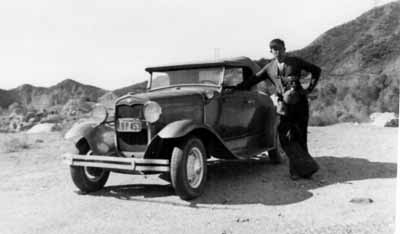
Bob with his sister's Model A
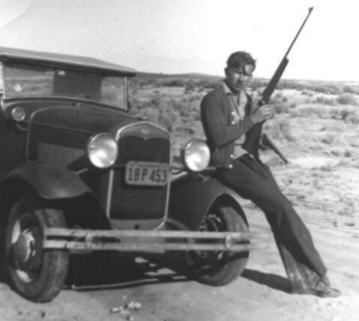

Chuck Dundore and Robert near the beach at Malibu, 1939
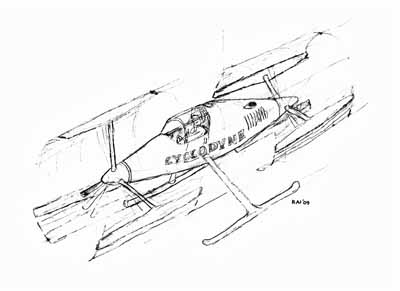
Bob drew this picture of the Cyclodyne from memory in early 2009
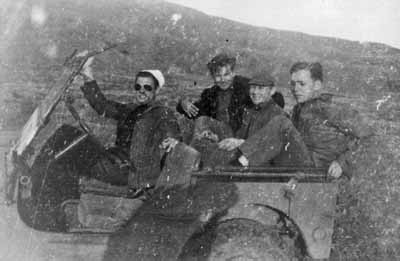
on San Clemente Island, photo by George Russon of the Canal Zone, circa 1939
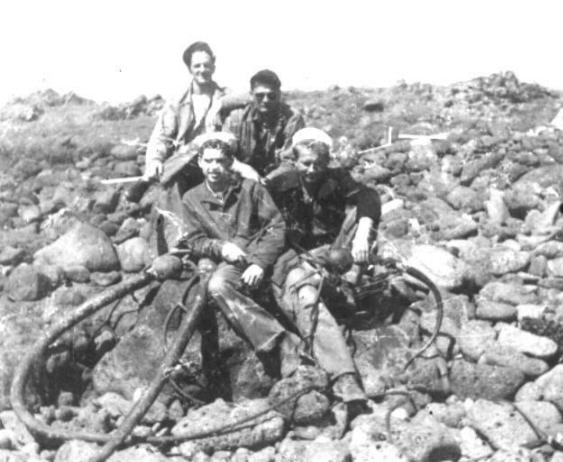
San Clemente Island, photo by George Russon of the Canal Zone; Top-left is Banny Bankemper of Lousville KY; top-right is George R., Lower-right: Robert
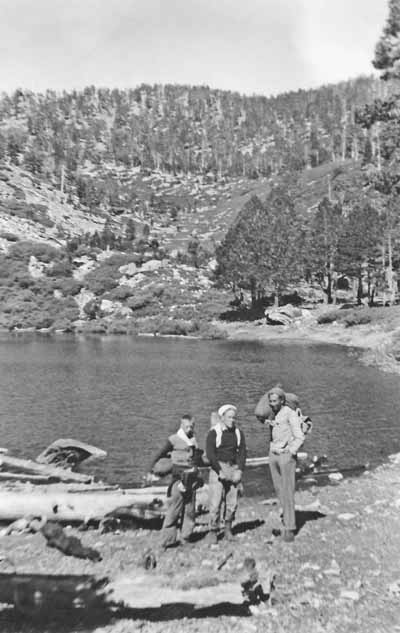
Richard Rydeen (Alstrup), Donald Rydeen(Alstrup), Bob at Dollar Lake, San Gorgonio Primitive Area, San Bernardino National Forest California 1939
Bob recalled:
I often think of lost friends. At Fremont High School in ’39 the California National Guard had a program where students could attend a weekly evening one-hour meeting and get paid $30 per month. My neighbors and classmates, Bob and Bill Wilson tried to interest me in this easy money, but I had read Dalton Trumbo’s WW1 novel, Johnny got his gun and that book scared me to abhor the threat of being cannon fodder.
During the Fall of ’41, I went to Exposition Park and sat with Bill and Bob where the 160th Infantry was assembled. The boys were sleeping that night in pup tents waiting for transportation to the Philippine Islands. In this visit I wished them well but said nothing about my resolve to avoid being cannon fodder. About 4 months later we got the word that Mac Arthur had surrendered the 160th to the Japanese, affirming my resolution to keep out of it.
DON and JIM RYDEEN (ALSTRUP)
Don and Jim were born Alstrup Their mother married Rydeen then divorced again. Confusion! Don and Bob were colleagues in the "News Delivery" business.
Bob recalled an "accident" where, while hunting rabbits with a 12 ga. shotgun, he discharged the gun into a cow patty. The angle of incidence of the splatter onto Don's back equalled the angle of incidence of the shot hitting the cow patty.
Don got revenge by disgorging chewed up cheez-its into an orange soda the 2 were sharing.
Dick Rydeen, in 1948, may have been associated with the break-up of the marriage of Jim Frank and Virginia(Ruth's sister -- Ruth is a future Mrs. Bob) by no fault of his own.
Although Don was a deepwater Signalman, his 3 years on Attu were boringly spent winter & summer occupying. His principal complaint was "it was so cold, his dick couldn't reach out to pee through all that thick clothing".
Incidentally, regarding Bob's stories:
Kvammen said "Don't ask Johnson expecting a simple answer, he'll give you a dissertation every time!"
Bob recalled:
My sister Marian was envied seriously by unemployed me (15 months older) when the week after her high school graduation she got a job as a telephone operator. She worked a split shift 7 days a week, 6AM till 10, then 2PM till 6PM.
Soon she was rolling in money, had a Model “A” Ford ragtop while I was walking the city for job interviews. Marian’s chum, Florence Lundeen had a job as a dancing girl in the Paramount Theater Vaudeville Show. Marian got a job there alongside Flossy rehearsing during her 10AM till 2PM break, then doing the introductory Can Can kick on the stage-wide chorus line at 9PM 7 days a week. I got back stage to smell those girls! Marian also went to a Modeling School and was walking around our house with a Phonebook balanced on her head. Several years later, I was browsing around a downtown LA shop that sold oddball things during my lunch hour and there was this table filled with thousands of little plastic tubes that you hold up to your eye and see semi-nude women posing and after studying a few of these tubes, there was Marian, bare breasted! I went through the whole pile to save my sister’s reputation and walked out with 17 tubes that I surreptitiously handed over to Marian at the first opportunity.
About this time, Bob also recalled:
Tim and I decided one fall weekend to drive my ’31 Model “A” Ford ragtop coupe down to see the Gulf of Baja.
About forty miles south of Mexicali, the dust on the road was so thin and deep that it got into the clutch and abraded the throw-out bearing, so that the clutch pedal would no longer permit us to get the car out of high gear. Stopping meant killing the engine. We made a “U” turn back to LA and kept moving until we came to a gas station, stopping and killing the engine in front of the pump.
After filling up, we together pushed the car and it started the engine and we jumped in and drove north. In the late afternoon we were getting hungry so we stopped the car facing downhill in front of a fruit stand in Julian. We had been sweating in Baja and were both drippy-muddy from that dust.
When the lady at the fruit stand saw us, she said…”We don’t need any pickers today”. We bought 10 pounds of the most delicious tasting apricots that I can recall and started the car by helping it to roll downhill.
Twas about 4AM Sunday morning when we went slowly through several red lighted and stop=signed intersections to arrive home, only stopping the car twice between Baja and LA.
THE CYCLODYNE
In 1939, as a result of my injury working as a pile-driver-man and after being fired by Bert Smith, I decided to seek less dangerous work and enrolled in the aircraft drafting course at Frank Wiggins Trade School in downtown Los Angeles. My teacher was Dave Cook and he recruited me to help him, for car fare, on his private invention called "Cyclodyne".
Dave was a retired Navy pilot who had worked on the "P-38" project at the Lockheed "Skunk works". The Cyclodyne was to be a high speed hovercraft. Dave was aware that the Sikorski-type helicopter had a speed limit, because the rotating radial wings in that type helicopter, when moving forward, had a problem with the wingtips when, in the advancing segment of their rotation were moving faster through the air than in the retreating segment. When the wing tip-speed approached the speed of sound, energy was diverted in a "sonic boom", and thus, faster speeds till involved this speed limit for Sikorski type helicopters.
Dave's hovercraft did not involve this problem. His craft consisted of rotary wings that rotated on hubs, axes aligned in the direction of travel so that the ends of the wing blades are always presented to the overtaken air. The lift vector moves seriously toward the advancing tips. Most helicopters are propelled forward by a force vector derived from the relation between the craft weight vector and the craft lift vector. The forward force vector is resisted by the drag force of the forward moving craft, gliding forward.
With the Cyclodyne, the rotating wing system drag is independent of the forward speed of the craft. Mechanical and strength of material problems, meanwhile have delayed Cyclodyne development for 70 years, if not the demise of most people concerned.
The proposed Cyclodyne consisted of 6 wings conformed on two contrarotating hubs arranged in the form seen on the McCormick-Deering wheat harvesting machines, wings spanwise are parallel to hub axes.
A gasoline-engine-powered, inertia-controlled transmission was to divide torque to the two rotating hubs to balance their lift vectors. Each wing was to be mounted centered on a radial strut extending from its hub. The cylindrical shaped path of each wing differentiated, along the wing's path, the lift vector by means of a sliding-rotatable cam located inside each hub.
The surface of this cam was to be profiled circumferentially and laterally, so that a spring-loaded tappet connected to a wrist pin behind the strut-wing hinge would regulate various angles of attack at each point along the wing's cylindrical path.
This cam, sliding and rotating with respect to the driveshaft provided the control for decreasing forehub's lift with respect to the aft hub's lift enabling gliding and the control for turning or rotating the craft.
Control of the 2 cams by the pilot's joystick was to be, by a rule ..... forward or aft motion of the stick results in forward or aft motion of the craft. Sideward motion of the stick results in rotating or turning the craft in that direction. Motion of the slide collar at the top of the stick results in unbalancing the power required to hover enabling similar craft motion up or down.
One of my contributions to the experiment was to borrow my mother' s sewing machine motor and variable speed foot pedal control to power a test stand for the first Cyclodyne rotor. After a few weeks, my mother insisted that I get her machine working again, which I did. A few weeks later I was inducted into the Sea Bees, where I resumed the duty of a Pile Driver Man in the Pacific Theater.
About 1960, quite by chance, I met Dave Cook Who said he was still trying to fund development of the Cyclodyne. When he learned that I was no longer in aviation, he commented, "What a waste of talent". The word Cyclodyne is apparently now the masthead property of a manufacturer of air conditioning equipment.
RAJ
INTERSTATE AIRCRAFT - THE CADET
Many of my mates from my drafting class graduating from Fremont High in ’38 were already employed as draftsmen at the booming local aircraft manufacturing companies, earning about 4 times what Smith had paid me, jobs that were not at all hazardous.
My Wiggins aircraft drafting class teachers were Theodore Woolsey, who had worked for Douglas as part of the company’s staff that supported the US Army’s 1924 Around-the-world flight, and David Cook, a retired US Navy Annapolis graduate carrier aircraft pilot with the experience of being a project engineer on Lockheed’s P-38 project.
While attending these aircraft drafting classes, Cook recruited some of us to voluntarily work on his private invention, a supersonic hovercraft idea that he called the Cyclodyne. In June ’39, Woolsey joined a start-up enterprise called Interstate Aircraft as their chief engineer, partnering with C. C. Smith, scion of the Smith Oil Tool Company, recruiting those members of our class of aircraft drafting students who would work for a pittance and travel to Interstate’s startup factory on Imperial Highway in El Segundo. I suffered through some austerity with these apprenticeship opportunities which gave us all, at least, the pleasure of some productive accomplishments.
DOUGLAS AIRCRAFT - THE XB-19
In November ’39, I was hired as a tracer, the entry level position of the Douglas Aircraft Company Engineering Department at Santa Monica, The tracer traces from pencil drawings onto linen cloth using pens and india ink, all atop an illuminated glasstop drawing table.
My supervisor, Bob Roof, noticing that my habit of starting the ink flow in my crow-quill pen on a test cloth produced credible illustrations, advanced me to the position of illustrator and I was placed under the supervision of Oliver Chayie, a technical writer with the assignment of compiling the Operating and Maintenance Instruction Manual for the Secret XB-19 project. Anyone with hobby and working experience with do-it-yourself automobile maintenance, home workshop, model building aircraft, and such, is better fitted for understanding, describing , illustrating and explaining how to do things than the others whose experiences have been confined to the other specialties of earning a living. I was enthusiastic about my work on the XB-19 opportunity.
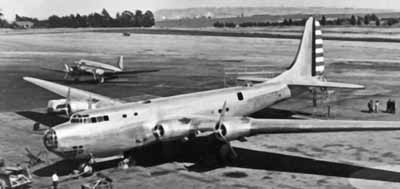
XB-19 after completion
The XB-19 was the world’s largest airplane at that time. The design included many never before attempted structures and systems, The project had been conceived in 1936 when the Russians had flown their experimental bomber unannounced from Moscow to March Field, California. When the XB-19 was test flown in 1943, offensive attack airplane technology had rendered the 1936 goals for long range bombing planes insufficient, and the only value that the XB-19 had was as a preliminary design for the various fleets of the smaller aircraft which won WWII. The XB-19 was junked after the war. One of its 8 foot diameter wheels is displayed at the Air force’s Museum at Wright Field, Ohio . I worked 80 hour weeks until July, 1943 when the grandmother of my neighbor who had been serving on Navy submarines since 1942, asked me ‘Why aren’t you out there fighting?’ I ended my aircraft career when I enlisted in the Navy in September 1943.
| |
|
|

 Back row: Thor, Judy, Bob. Front row: Pearl Lamont(the grandmother of Marian's neighbor friend Pearl Hosterman), Mrs. and Mr. Ed Burroughs, and Marian. According to Bob, "Ed was our 'across-the-alley' neighbor, who was a retired photographer from Tombstone AZ. He was in Tombstone at the time of the Earp-Clanton shootout at the OK Corral, and taught me how to develop my own photos". This park bench is in Bixby Park, Long Beach
Back row: Thor, Judy, Bob. Front row: Pearl Lamont(the grandmother of Marian's neighbor friend Pearl Hosterman), Mrs. and Mr. Ed Burroughs, and Marian. According to Bob, "Ed was our 'across-the-alley' neighbor, who was a retired photographer from Tombstone AZ. He was in Tombstone at the time of the Earp-Clanton shootout at the OK Corral, and taught me how to develop my own photos". This park bench is in Bixby Park, Long Beach



















